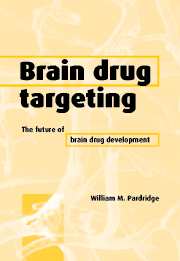Book contents
- Frontmatter
- Contents
- Preface
- List of abbreviations
- 1 Drug targeting, drug discovery, and brain drug development
- 2 Invasive brain drug delivery
- 3 Lipid-mediated transport and carrier-mediated transport of small molecules
- 4 Receptor-mediated transcytosis of peptides
- 5 Vector discovery: genetically engineered Trojan horses for drug targeting
- 6 Linker strategies: the engineering of multifunctional drug formulations
- 7 Protein neurotherapeutics and peptide radiopharmaceuticals
- 8 Antisense neurotherapeutics and imaging gene expression in vivo
- 9 Gene therapy of the brain
- 10 Blood–brain barrier genomics
- References
- Index
- Plate section
3 - Lipid-mediated transport and carrier-mediated transport of small molecules
Published online by Cambridge University Press: 08 January 2010
- Frontmatter
- Contents
- Preface
- List of abbreviations
- 1 Drug targeting, drug discovery, and brain drug development
- 2 Invasive brain drug delivery
- 3 Lipid-mediated transport and carrier-mediated transport of small molecules
- 4 Receptor-mediated transcytosis of peptides
- 5 Vector discovery: genetically engineered Trojan horses for drug targeting
- 6 Linker strategies: the engineering of multifunctional drug formulations
- 7 Protein neurotherapeutics and peptide radiopharmaceuticals
- 8 Antisense neurotherapeutics and imaging gene expression in vivo
- 9 Gene therapy of the brain
- 10 Blood–brain barrier genomics
- References
- Index
- Plate section
Summary
Introduction
Central nervous system (CNS) drug development is derived from CNS drug discovery (Chapter 1), and CNS drug discovery is based on structure–activity relationships (SAR), which determine the affinity of the drug for its cognate receptor. However, the typical CNS drug discovery program leads to a drug candidate that is highly active in vitro with very favorable SAR, but has little biologic activity in the brain in vivo, because of poor transport through the blood–brain barrier (BBB). The drug discovery program is then terminated. Since >98% of all drug candidates that emanate from a high-throughput screening drug discovery program do not cross the BBB (Pardridge, 1998a), the inherent efficiency of the CNS drug development program is low. This efficiency could be increased by incorporating structure–transport relationships (STR) early in the drug discovery phase in parallel with SAR (Figure 3.1). The STR are derived from CNS drug-targeting principles.
The STR factors controlling small molecule transport through the BBB are shown in Figure 3.2. The STR of a given drug will allow for prediction of the BBB permeability–surface area (PS) product. The in vivo CNS pharmacologic effect of a drug is proportional to the brain uptake of the drug, expressed as a percentage of injected dose per gram brain (%ID/g). The %ID/g is an equal function of both the BBB PS product and the plasma area under the drug ncentration curve (AUC), as shown in Figure 3.2. While the BBB PS product is directly proportional to the membrane permeation of the drug, the plasma AUC is inversely related to the membrane permeation of the drug.
- Type
- Chapter
- Information
- Brain Drug TargetingThe Future of Brain Drug Development, pp. 36 - 81Publisher: Cambridge University PressPrint publication year: 2001
- 2
- Cited by

